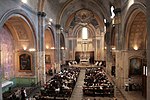Battle of Rhone Crossing

The Battle of the Rhône Crossing was a battle during the Second Punic War in September of 218 BC. Hannibal marched on the Italian Alps, and an army of Gallic Volcae attacked the Carthaginian army on the east bank of the Rhône. The Roman army camped near Massalia. The Volcae tried to prevent the Carthaginians from crossing the Alps and invading Italy. Before they crossed the river, the Carthaginians sent a detachment to cross upriver, under Hanno, son of Bomilcar, and took up position behind the Gauls. Once the detachment was in place, Hannibal crossed the river with the main contingent of his army. As the Gauls massed to oppose Hannibal, Hanno attacked their rear and routed the Volcae army. This was Hannibal's first major battle (victory) outside of the Iberian Peninsula. It gave him an unopposed path to the Alps and into Italy.
Excerpt from the Wikipedia article Battle of Rhone Crossing (License: CC BY-SA 3.0, Authors, Images).Battle of Rhone Crossing
Boulevard Édouard Daladier, Carpentras
Geographical coordinates (GPS) Address Nearby Places Show on map
Geographical coordinates (GPS)
| Latitude | Longitude |
|---|---|
| N 44.138333055556 ° | E 4.8097219444444 ° |
Address
Boulevard Édouard Daladier 357
84100 Carpentras, Baron
Provence-Alpes-Côte d'Azur, France
Open on Google Maps










